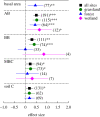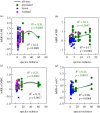Species richness promotes ecosystem carbon storage: evidence from biodiversity-ecosystem functioning experiments
- PMID: 33234078
- PMCID: PMC7739490
- DOI: 10.1098/rspb.2020.2063
Species richness promotes ecosystem carbon storage: evidence from biodiversity-ecosystem functioning experiments
Abstract
Plant diversity has a strong impact on a plethora of ecosystem functions and services, especially ecosystem carbon (C) storage. However, the potential context-dependency of biodiversity effects across ecosystem types, environmental conditions and carbon pools remains largely unknown. In this study, we performed a meta-analysis by collecting data from 95 biodiversity-ecosystem functioning (BEF) studies across 60 sites to explore the effects of plant diversity on different C pools, including aboveground and belowground plant biomass, soil microbial biomass C and soil C content across different ecosystem types. The results showed that ecosystem C storage was significantly enhanced by plant diversity, with stronger effects on aboveground biomass than on soil C content. Moreover, the response magnitudes of ecosystem C storage increased with the level of species richness and experimental duration across all ecosystems. The effects of plant diversity were more pronounced in grasslands than in forests. Furthermore, the effects of plant diversity on belowground plant biomass increased with aridity index in grasslands and forests, suggesting that climate change might modulate biodiversity effects, which are stronger under wetter conditions but weaker under more arid conditions. Taken together, these results provide novel insights into the important role of plant diversity in ecosystem C storage across critical C pools, ecosystem types and environmental contexts.
Keywords: ecosystem carbon stock; meta-analysis; microbial biomass carbon; plant biomass; plant species richness; soil carbon.
Conflict of interest statement
We declare we have no competing interests.
Figures







References
-
- Tilman D, Isbell F, Cowles JM. 2014. Biodiversity and ecosystem functioning. Annu. Rev. Ecol. Evol. Syst. 45, 471–493. ( 10.1146/annurev-ecolsys-120213-091917) - DOI
Publication types
MeSH terms
Substances
Associated data
LinkOut - more resources
Full Text Sources
